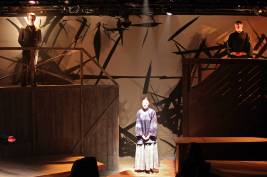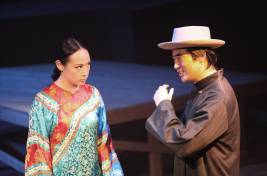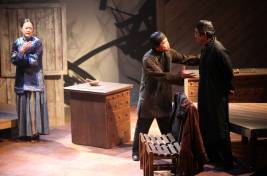
Late 19th century Los Angeles history comes to vivid, complex, highly theatrical life in The Chinese Massacre (Annotated), award-winning playwright Tom Jacobson’s latest World Premiere, and once again (as with Jacobson’s Ouroboros, Bunbury, and The Twentieth Century Way), audiences are in for something special indeed.
The historical incident in question is the 1871 lynching of a dozen and a half Chinese men by a mob of five hundred Angelinos (about ten percent of the city’s population), L.A.’s first though certainly not its last race riot, as the Zoot Suit Riot of 1943, the Watts Riots of ‘65, and the Los Angeles riots of ’92 went on to prove.
A more conventional playwright might approach this subject with a deliberately careful adherence to historical accuracy, a linear timeline, and a clearly distinct cast of characters with one actor per role. Not Tom Jacobson, and The Chinese Massacre (Annotated) is all the richer and theatergoers all the more rewarded for this alternately serious and tongue-in-cheek approach.
Jacobson footnotes his play with spoken “annotations” by several cast members, historical tidbits that serve to fascinate, inform, and tickle the funny bone, often all at once.
One annotator tells us straight-facedly that these annotations are to “distance the audience from the emotionality of the story in the style of Bertolt Brecht’s epic theater,” then adds that unlike the printed footnotes that most people skip, “here, stuck in your theatre seat, you will endure them all.” Some annotations are Trivial Pursuit-worthy, e.g. “the population of Los Angeles in 1890 was 50,395, ranking 57th in the nation.” Another annotator reveals why most of the cast play multiple roles: “Not only does this conceit save money on actor stipends, it also heightens the theatricality of the alienation effect.” Chunks of dialog are in Chinese, though an annotator explains that “rather than have all the Chinese characters sound like Hop Sing from Bonanza, when they are alone together, the Cantonese they are speaking is rendered in [fluent, unaccented] English.” Annotations also disclose when the playwright is fiddling with history: “Following in the footsteps of the historian Paul De Falla who wrote the widely known 1960 article Lantern In The Western Sky, this play conflates the two marriages, telescoping events to heighten tension and conflict.” You get the picture.
The Chinese Massacre opens in 1891 with the arrival of Mr. Lee, an English-speaking American-garbed Chinese man of forty or so, at the parlor of a certain Reverend Crenshaw. Lee wishes, he explains, to purchase the “preserved Chinese finger, right pinky” that Crenshaw has advertised for sale. Flashbacks to 1871 fill us in on the reasons for Lee’s interest in the “chinky pinky,” reasons that take us back to the wedding ceremony of Lee Tong and Yut Ho, two young Chinese living in Los Angeles, an arranged marriage which an annotator informs us was “a way of changing ownership of Chinese women from one company to another. Often they were kidnapped, as was Yut Ho. She was previously married to a Chinese man from the Ning Yung Company in a Chinese ceremony. You would already know that if you spoke Cantonese.”
Lee Tong and Yut Ho’s wedding sets off a series of events including the killing of a Chinese thug hired by Yut Ho’s first husband’s company, followed by the crossfire shooting of Jesus Bilderrain, a Mexican-born Los Angeles policeman. What then transpired in real life, and what ends the first act of The Chinese Massacre (Annotated) with more than a few bangs, has been described in a recent LA Weekly article as “an orgy of violence shocking even by the decadent standards of the city of Los Angeles,” one which involved the mob lynching of “seventeen Chinese men and boys, including a popular doctor … near what is now Union Station.”
The World Premiere production of The Chinese Massacre (Annotated) features a cast of fourteen playing forty-six roles (counting the four annotators). Not only is there a good deal of Chinese (and Spanish) spoken in the play, Jacobson often has two scenes unfolding at the same time, with two sets of dialog spoken simultaneously. Not surprisingly, the result of all this makes for substantial mental and sensory overload. You may find yourself comparing notes at intermission about what you’ve just seen. And yet, for this reviewer at least, whatever confusion I felt during the first act, confusion that may indeed have been the playwright’s intention, mattered hardly a whit. (The play’s gripping second act, with very little overlapping dialog, is considerably easier to follow.)
The Chinese Massacre (Annotated) is ambitious, audacious, and highly entertaining from start to finish. Jeff Liu’s ingenious direction keeps things moving lickety-split, and works considerably towards reducing (if not completely eliminating) whatever confusion is inherent and probably deliberate in Jacobson’s script.
As for the for the actors who bring L.A. history to life, they simply could not be better, jumping from role to role, quick changes of accessories and accents helping to distinguish one role from another. Since commenting on each performer and every role would be a Herculean task, this review will simply list their names, after each of which you may insert your adjective of choice: “terrific,” “splendid,” “amusing,” “delightful,” “charming,” “forceful,” … Take your pick to describe the work of Richard Azurida, Warren Davis, Anna Douglas, Elizabeth Ho, Ross Kurt Le, Jully Lee, Alex Levin, West Liang, Johanna McCay, Silas Weir Mitchell, Gary Patent, Jack Sochet, Lisa Tharps, and Ryun Yu.
The Chinese Massacre (Annotated) is a design dazzler, starting with Sibyl Wickersheimer’s imaginative set, which suggests both Asia and the Old West through the slight haze of stage smoke which replicates the dusty air of late 19th Century L.A. Thomas Ontiveros’s lighting design is spectacular and varied, Dianne K. Graebner’s costumes and Michael O’Hara’s properties are perfect replications of the play’s time frame, and Dennis Yen’s sound design is a stunner as well. Kudos go to Tracy Winters’ dialect coaching (Tuffet Schmelzle is associate dialog coach) and to Diana Lee Inosanto and Ron Balicki’s fight choreography. Katherine E. Haan is stage manager, Anna McGill assistant stage manager. The Chinese Massacre (Annotated) is produced for Circle X Theatre Co. by Tim Wright and Jennifer A. Skinner and associate produced by Jen Kays and Camille Schenkkan.
As if World Premiering one play were not already enough, the ambitious, audacious Mr. Jacobson has a second play debuting on the adjoining stage at the Atwater Village Theatre, Ensemble Studio Theatre’s production of House Of The Rising Son.
The Chinese Massacre (Annotated) further cements Tom Jacobson’s reputation as one of our finest and most fascinating contemporary playwrights. It is a play that will mesmerize you, make you think, set you to researching Los Angeles history, and most of all, keep you thoroughly entertained from start to finish.
Circle X Theatre @ Atwater Village Theatre, 3269 Casitas Ave., Atwater Village.
www.circlextheatre.org
–Steven Stanley
April 22, 2011
Photos: Shane William Zwiener





 Since 2007, Steven Stanley's StageSceneLA.com has spotlighted the best in Southern California theater via reviews, interviews, and its annual StageSceneLA Scenies.
Since 2007, Steven Stanley's StageSceneLA.com has spotlighted the best in Southern California theater via reviews, interviews, and its annual StageSceneLA Scenies.







 COPYRIGHT 2024 STEVEN STANLEY :: DESIGN BY
COPYRIGHT 2024 STEVEN STANLEY :: DESIGN BY